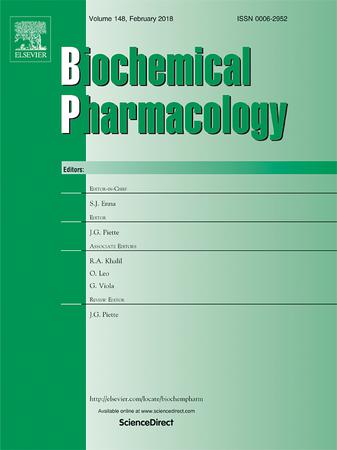高亲和力Sybody在体外和癌细胞中阻断Cofilin-1与F-actin的结合。
IF 5.3
2区 医学
Q1 PHARMACOLOGY & PHARMACY
引用次数: 0
摘要
肌动蛋白切断蛋白Cofilin-1的上调通过促进肌动蛋白转换和增加细胞运动性参与多种癌症类型的恶性肿瘤。尽管靶向Cofilin-1很重要,但目前缺乏特异性靶向其阻断活性的抑制剂。为了解决这个问题,我们合成了抗Cofilin-1纳米体(Sybodies)来干扰人Cofilin-1与丝状肌动蛋白的结合。我们鉴定了四种高亲和力的人Cofilin-1的Sybodies,其解离常数(KD)在纳摩尔范围内,可以抑制G-actin的分离,并在体外抑制Cofilin-1的肌动蛋白切断活性。值得注意的是,Sybody B12的KD最低,约为27 nM,可竞争性地阻断actin与Cofilin-1的结合,并抑制小鼠Cofilin-1的G-actin隔离。Sybody-B12-Cofilin-1复合物的晶体结构(分辨率为1.8 Å)显示,Sybody B12与Cofilin-1的G-actin结合位点结合,表明Sybody B12与Cofilin-1的结合位点相同。在人H1299肺癌细胞中,短暂表达mplum标记的Sybody B12可以抑制增强型绿色荧光蛋白(EGFP)-Cofilin-actin棒的形成。值得注意的是,Sybody B12的稳定表达不影响H1299细胞的活力,并且在表达Sybody B12的H1299细胞中未检测到Cofilin-2或ADF mRNA的代偿上调。总之,这些发现表明Sybody B12显示出抑制Cofilin-1与actin相互作用的强大潜力。此外,它还可以作为设计Cofilin-1硅基抑制剂的有前途的先导结构。本文章由计算机程序翻译,如有差异,请以英文原文为准。

A high affinity Sybody blocks Cofilin-1 binding to F-actin in vitro and in cancer cells
Upregulation of the actin-severing protein Cofilin-1 is implicated in enhancing malignancy of various cancer types by promoting actin turnover and increasing cellular motility. Despite the importance of targeting Cofilin-1, currently there is a lack of inhibitors specifically targeting its actin-severing activity. To address this issue, we generated synthetic anti-Cofilin-1 nanobodies (Sybodies) that interfere with human Cofilin-1 binding to filamentous actin. We identified four high affinity Sybodies against human Cofilin-1 with dissociation constants (KD) in the nanomolar range that inhibited G-actin sequestration, and actin-severing activity of Cofilin-1 in vitro. Notably, Sybody B12, with the lowest KD of approximately 27 nM, competitively blocked actin binding to Cofilin-1, and also inhibited G-actin sequestration of murine Cofilin-1. The crystal structure of the Sybody-B12-Cofilin-1 complex, resolved at 1.8 Å, revealed that Sybody B12 binds to the G-actin binding site of Cofilin-1, showing that Sybody B12 engages the same binding site on Cofilin-1 as actin. Consistently, transient expression of mPlum-tagged Sybody B12 in human H1299 lung cancer cells inhibited the formation of enhanced green fluorescent protein (EGFP)-Cofilin-actin rods. Notably, stable expression of Sybody B12 did not affect viability of H1299 cells, and no compensatory up-regulation of Cofilin-2 or actin-depolymerization factor (ADF) mRNA were detectable in Sybody B12 expressing H1299 cells. Together, these findings suggest that Sybody B12 exhibits a strong potential as tool for inhibiting the interaction of Cofilin-1 with actin. In addition, it could serve as a promising lead structure for designing Cofilin-1 inhibitors in silico.
求助全文
通过发布文献求助,成功后即可免费获取论文全文。
去求助
来源期刊

Biochemical pharmacology
医学-药学
CiteScore
10.30
自引率
1.70%
发文量
420
审稿时长
17 days
期刊介绍:
Biochemical Pharmacology publishes original research findings, Commentaries and review articles related to the elucidation of cellular and tissue function(s) at the biochemical and molecular levels, the modification of cellular phenotype(s) by genetic, transcriptional/translational or drug/compound-induced modifications, as well as the pharmacodynamics and pharmacokinetics of xenobiotics and drugs, the latter including both small molecules and biologics.
The journal''s target audience includes scientists engaged in the identification and study of the mechanisms of action of xenobiotics, biologics and drugs and in the drug discovery and development process.
All areas of cellular biology and cellular, tissue/organ and whole animal pharmacology fall within the scope of the journal. Drug classes covered include anti-infectives, anti-inflammatory agents, chemotherapeutics, cardiovascular, endocrinological, immunological, metabolic, neurological and psychiatric drugs, as well as research on drug metabolism and kinetics. While medicinal chemistry is a topic of complimentary interest, manuscripts in this area must contain sufficient biological data to characterize pharmacologically the compounds reported. Submissions describing work focused predominately on chemical synthesis and molecular modeling will not be considered for review.
While particular emphasis is placed on reporting the results of molecular and biochemical studies, research involving the use of tissue and animal models of human pathophysiology and toxicology is of interest to the extent that it helps define drug mechanisms of action, safety and efficacy.
 求助内容:
求助内容: 应助结果提醒方式:
应助结果提醒方式:


